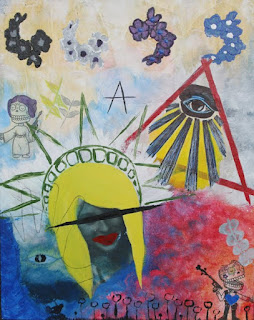


 BASICSLow Fire Clay
BASICSLow Fire Clay is usually for form (or sculpture)
High Fire Clay is usually for function (dishes or outdoor sculpture)
Why? Earthenware clays (low fire) melt at such low temperatures that they seldom become fully vitrified. Because of this, the fired piece will continue to absorb liquids.
We will be using low fire clay in class. DO NOT PUT THE PIECES YOU MAKE IN THIS CLASS IN THE DISHWASHER, OVEN OR MICROWAVE!
Vitrified: To change a substance so it becomes glass or a glassy substance, usually through heat fusion.
 Clay:
Clay: Alumina + silica + water
CLAY STAGES:Wedging: A method of kneading clay to prepare it for use. Wedging presses the air bubbles out of the clay. If you have air bubbles in your clay it will explode during firing.
Leather Hard: Stage of the clay between plastic and bone dry. Clay is still damp enough to join it to other pieces using slip. For example, this is the stage handles are applied to mugs.
Bone Dry: Completely air dried.
Greenware: This refers to ceramic ware that has not been fired.
Firing: This is the process of heating the pottery to a specific temperature in order to bring about a particular change in the
clay or the surface. Clay is fired in a kiln. Do NOT touch the kiln!
Bisque: The term bisque refers to ceramic ware that has been fired once without glaze.
Glaze: A glass-like surface coating for ceramics that is used to decorate and seal the pores of the fired clay.
 TECHNIQUES
TECHNIQUES
Score and Slip: Score and slip refers to a method of joining two pieces of clay together. First, score the clay; this means that you make scratches in the surfaces that will be sticking together. Then you slip it; that is you wet the surface with some slip, using it like glue. Next, you press the two pieces together. It is very important to always score and slip clay that is leather hard. If you do not, the pieces will likely pop apart when they are fired.
Coil: This is the technique of building ceramic forms by rolling out coils, or ropes, of clay and joining them together with the fingers or a tool.
Pinch: "Pinch" in ceramics is a method of shaping clay by inserting the thumb of one hand into the clay and lightly pinching with the thumb and fingers while slowly rotating the ball in the palm of the other hand.
Pots made in this manner are called "pinch pots".
Handbuilding: This term refers to the one of several techniques of building pots using the only the hands and simple tools rather than the potters wheel.
Molding: In this technique, flat slabs of clay are pressed into molds in order to create various shapes or forms.
Throwing on the Potters Wheel: A device with either a manual (foot powered) or an electric rotating wheel head used to sit at and make pottery forms. Potters create vases, pots, bowls, platters and so on by throwing on the potters wheel.
 CLEAN UP
CLEAN UP1. Put excess clay in a bowl. At the end of the class period wedge the clay and put back into your bag. If clay is excessively wet you may put it on the plaster for the class period and put it in the bag at the end of class.
2. Clean your area by scraping off clay from the table.
3. Finish cleaning your work area by using a sponge to wipe the table off.
4. Scrape clay off of your hands and put into your bag or the large clay bin.
5. Rinse remaining clay off of your hands in the bucket.
6. AFTER you have gotten the clay off in the water bucket THEN you can wash your hands in the sink.
7. Put tools and materials away.
DO NOT PUT CLAY IN SINK
DO NOT WASH HANDS IN SINK WITHOUT USING THE BUCKET FIRST!!!Students that clean up improperly will be assigned to cleaning up the whole room.
6th Period is to dump the water bucket 5 minutes prior to the end of class each day.
1st Period is to put fresh water in the bucket every day.
CERAMICS TIMELINEDemo on throwing first
Students will sign up to throw a pot. Each student will have 3 to 7 class periods to throw, depending on class size and wheel availability. Throwing a pot may count as a project, but is not required due to lack of sufficient number of wheels. So if you are interested in throwing, please try it!
THROWING: COPS = Center, Open, Pull, Shape. Once leather hard you trim the bottom.
Project One: Musical Spheres or Christmas Ornament for Washington Tree Project
Score and Slip
Texture
Project Two: Subtractive Sculpture
Carving
Form
Negative and Positive Space
Project Three: Mask
Mold
Score and Slip
Texture
Sculpting
Expression
Project Four: Vessel Construction
Hand building
Slabs
Score and Slip
Texture
Sculpting
IMPORTANT: It's important to never have clay over 1" thick and that there are no air bubbles in the clay! Enclosed sculptures MUST have a hole to let out hot air. If the clay is too thick or there are air bubbles in the clay, it will EXPLODE during firing! This will ruin not only your work of art, but everyone else's as well.
If your work explodes you must redo the assignment and apologize to everyone else that had damage done to their artwork.
Each student will get 25 pounds of clay (one bag).
This is enough to finish all of your projects.
Do not punch or poke holes into your clay.
Wrap back up after each use!
Clean up your work area every day!
Students no responsible with clay usage will be assigned to other projects for the rest of the semester.





























